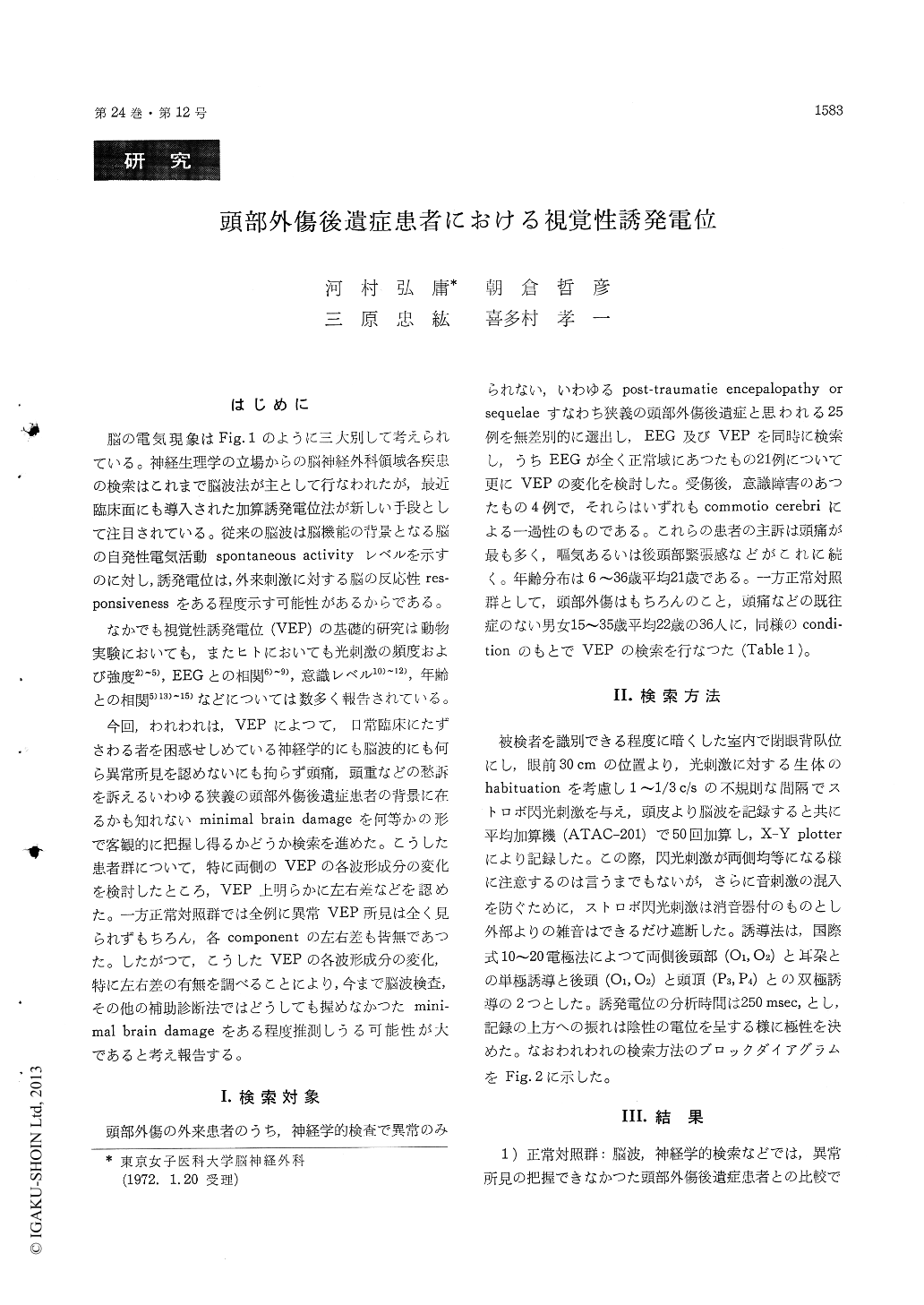Japanese
English
- 有料閲覧
- Abstract 文献概要
- 1ページ目 Look Inside
はじめに
脳の電気現象はFig.1のように三大別して考えられている。神経生理学の立場からの脳神経外科領域各疾患の検索はこれまで脳波法が主として行なわれたが,最近臨床面にも導入された加算誘発電位法が新しい手段として注目されている。従来の脳波は脳機能の背景となる脳の自発性電気活動spontaneous activityレベルを示すのに対し,誘発電位は,外来刺激に対する脳の反応性res—ponsivenessをある程度示す可能性があるからである。
なかでも視覚性誘発電位(VEP)の基礎的研究は動物実験においても,またヒトにおいても光刺激の頻度および強度2)〜5),EEGとの相関6)〜9),意識レベル10)〜12),年齢との相関5)13)〜15)などについては数多く報告されている。
今回,われわれは,VEPによつて,日常臨床にたずさわる者を困惑せしめている神経学的にも脳波的にも何ら異常所見を認めないにも拘らず頭痛,頭重などの愁訴を訴えるいわゆる狭義の頭部外傷後遺症患者の背景に在るかも知れないminimal brain damageを何等かの形で客観的に把握し得るかどうか検索を進めた。こうした患者群について,特に両側のVEPの各波形成分の変化を検討したところ,VEP上明らかに左右差などを認めた。一方正常対照群では全例に異常VEP所見は全く見られずもちろん,各componentの左右差も皆無であつた。したがつて,こうしたVEPの各波形成分の変化,特に左右差の有無を調べることにより,今まで脳波検査,その他の補助診断法ではどうしても握めなかつたmini—mal brain damageをある程度推測しうる可能性が大であると考え報告する。
In this paper, the authors would like to inform about the clinical application and findings of visual evoked potentials (it will be abbreviated as VEP)in the post-traumatic encephalopathy.
VEPs were studied in 25 patients who had color-ful complaints without any abnormal neurological and/or electroencephalographic findings, comparing with the findings in 36 normal healthy subjects.
The subjects lying with closed eyes on a bed in the EEG laboratory, were confronted to a sequence of flashes from a stroboscope placed in front of themselves.
Electrodes were placed at the occipital and parietal regions according to the 10-20 electrode system, with reference electrodes on both ear lobes. Electroencephalographic responses to fifty flashes of 1 or 1/3 cycle per second were additively summed up by means of digital type of computor. The results were visualized on a screen and recorded by an X-Y plotter. During the stimulation, usual EEG also recorded in order to check the conscious-ness level of the subjects. Flashes were delivered only when the subjects showed the arousal EEG pattern. The analysis time of VEP was 250 msec. and the upward deflection indicates negative electricity.
i ) Normal healthy control group :
VEPs in all of the healthy subjects appeared to be symmetric between two hemispheres over the occipital region. Although there were some inter-individual variations, five peaks could be identified in the normal VEPs. The first negative peak ( I ) appeared with a latency of 39.0 msec. and the first positive one (II) with that of 54.8 msec., followed by the second negative (III, 70.0), second positive (IV, 115.6 msec.) and the third negative (V, 132.5 msec.) ones.
ii) VEPs in post-traumatic encephalopathy :
Abnormal VEPs were found in 16 cases out of 25 (76.2%). Abnormality of VEP in these patients could be classified in 4 types as illustrated in Fig. 6, comparing with each components of bilateral VEPs recorded from occipital region transcranially. The first type (A) was characterized by delayed latency of each components unilaterally in 3 cases. The second type (B) was flattening of unilateral lead in 6 cases. The third type (C) was only difference of amplitude of bilateral VEPs (in the other words, the lowering of the affected side) in 4 cases. The last type (D) was disappearance or lacking of either early or late components in 3 cases.
On the other hand, correlation between these types of abnormal VEP pattern and existence of cerebral concussion was not so significant. There was also no definite correlation between these VEP changes and the site of hit by head injuries. The most frequently observed changes in abnormal VEPs of post-traumatic encephalopathy werelowering of the amplitute and delayed latency. The incidence for peak III (100%) was significantly most frequent in all cases as well as normal heal-thy subjects. Appearances of peak I and II were not so stable in comparison with that of normal control group. Reduction of amplitude of peak I and II and derangements of early components in VEP were prominent even in the cases displaying normal EEG findings.
So far as regarding with the localization of cerebral damage the diagnostic value of VEP seem-ed to be not necessarily more beneficial than con-ventional EEG. However, according to our experi-ence, VEP recording, especially asymmetry of components of VEPs, was considered to be useful in clinical practice as to detect even a traumatic minimal brain damage.
The authors might be able to consider that VEPs is possible detect abnormality of cortical responsive-ness caused by a slight minor damage even in the cases of normal neurology and EEG.

Copyright © 1972, Igaku-Shoin Ltd. All rights reserved.


